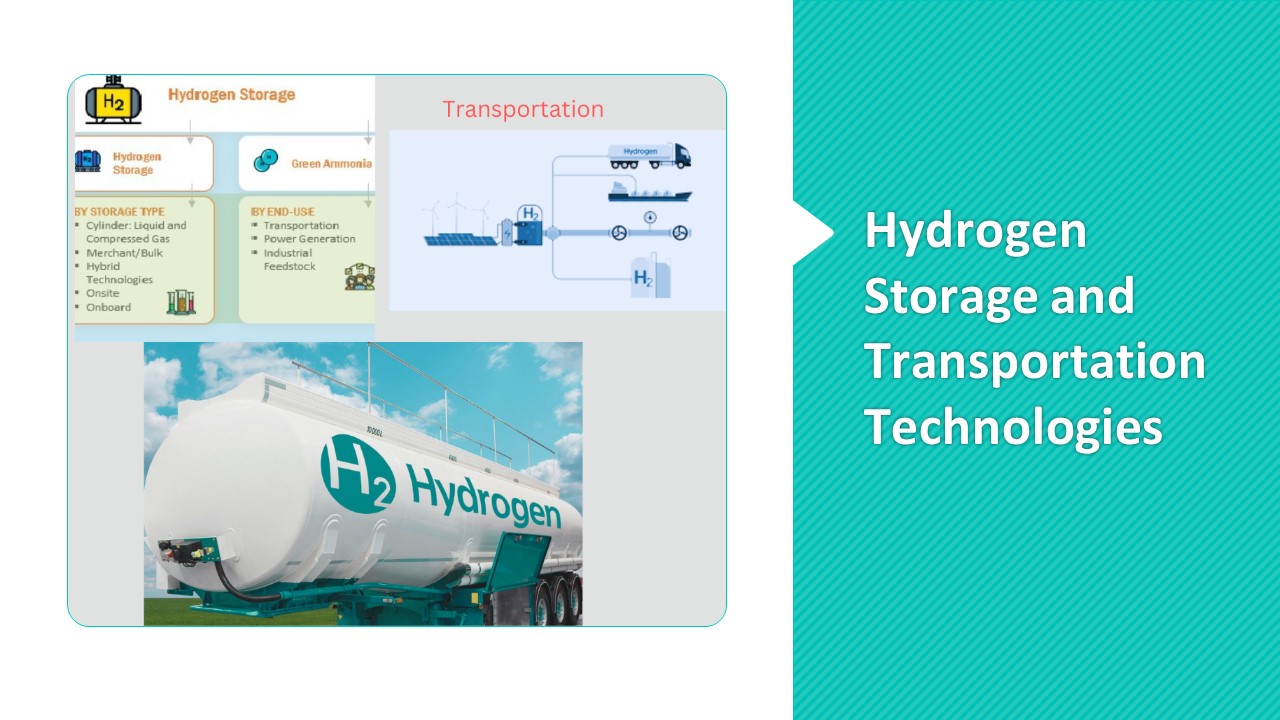Hydrogen Storage and Transportation Technologies (1) - PowerPoint PPT Presentation
Title:
Hydrogen Storage and Transportation Technologies (1)
Description:
Hydrogen Storage and Transportation Technologies - Cost and Supply Chain Analysis. Current and evolving hydrogen storage and transportation technologies aim to address the challenges of storing and transporting hydrogen efficiently and safely. – PowerPoint PPT presentation
Number of Views:11
Title: Hydrogen Storage and Transportation Technologies (1)
1
Hydrogen Storage and Transportation Technologies
2
- Hydrogen Storage and Transportation Technologies
- Cost and Supply Chain Analysis. - Current and evolving hydrogen storage and
transportation technologies aim to address the
challenges of storing and transporting hydrogen
efficiently and safely. - Infrastructure Development
- Pipelines Evaluate the need for new pipelines or
modifications to existing ones to transport
hydrogen. Consider factors such as material
compatibility, pressure requirements, and the
need for compression stations along the pipeline. - Storage Tanks Assess the capacity and type of
storage tanks required at production sites,
distribution points, and end-user locations.
Different forms of hydrogen (gaseous or liquid)
may require specific types of storage tanks. - Refueling Stations Establish or upgrade
refueling stations for hydrogen-powered vehicles.
This includes both public and private stations,
considering factors like accessibility, safety
features, and user convenience.
3
- 2. Safety and Regulatory Compliance
- Safety Protocols Develop comprehensive safety
protocols for the entire hydrogen supply chain,
addressing potential hazards associated with
production, storage, and transportation. - Regulatory Compliance Ensure compliance with
local, national, and international regulations
governing the handling, storage, and
transportation of hydrogen. This may involve
collaboration with regulatory bodies to establish
industry standards. - 3. System Integration
- Compatibility Assess the compatibility of new
technologies with existing infrastructure,
equipment, and processes. Retrofit or upgrade
existing facilities as needed to seamlessly
integrate hydrogen storage and transportation. - Interoperability Ensure interoperability between
different components of the supply chain, such as
hydrogen production facilities, storage systems,
and transportation modes, to create a cohesive
and efficient system.
4
- 4. Logistics and Distribution Planning
- Network Design Optimize the logistics and
distribution network for hydrogen, considering
the locations of production facilities,
end-users, and demand centers. This involves
strategic placement of distribution hubs and
pipelines to minimize transportation costs. - Storage and Handling Develop protocols for
handling and storing hydrogen during transit,
including considerations for minimizing losses
and ensuring product quality upon delivery. - Demand Forecasting Implement robust demand
forecasting systems to anticipate variations in
hydrogen consumption. This helps in optimizing
the distribution plan and avoiding supply chain
bottlenecks. - 5. Environmental Impact
- Life Cycle Analysis Conduct a thorough life
cycle analysis to assess the environmental impact
of the integrated hydrogen supply chain. This
includes evaluating the emissions associated with
production, transportation, and end-use, and
identifying opportunities for improvement and
sustainability.
5
- 6. Training and Education
- Workforce Training Provide training programs for
personnel involved in the hydrogen supply chain,
focusing on safety protocols, emergency response
procedures, and the proper handling of hydrogen. - Public Awareness Educate the public, especially
in areas with new hydrogen infrastructure, about
the safety measures in place, benefits of
hydrogen, and the role it plays in a sustainable
energy future. - DOWNLOAD- https//www.marketsandmarkets.com/indust
ry-practice/RequestForm.asp
6
- Applications of Hydrogen Storage and
Transportation Technologies - Fuel Cell Vehicles (FCVs)
- Transportation Hydrogen storage and
transportation technologies are essential for
fueling stations that supply hydrogen to fuel
cell vehicles. These vehicles, including cars,
buses, and trucks, use hydrogen to generate
electricity in fuel cells, producing only water
vapor as a byproduct. - Industrial Processes
- Hydrogen Production Facilities Efficient storage
and transportation systems are critical for
supplying hydrogen to industrial facilities.
Industries such as petroleum refining, chemical
production, and metal processing often use
hydrogen as a feedstock or as a reducing agent.
7
- 3. Power Generation
- Backup Power Systems Hydrogen can be stored and
transported for use in backup power systems,
providing a reliable and clean energy source for
applications such as data centers,
telecommunication towers, and remote power
generation. - 4. Renewable Energy Integration
- Energy Storage Hydrogen can serve as a means of
storing excess energy generated from renewable
sources, such as wind or solar power. - 5. Aerospace
- Rocket Propulsion Hydrogen is commonly used as a
fuel in rockets due to its high energy content
and clean combustion. Effective storage and
transportation systems are crucial for supplying
hydrogen fuel to space launch facilities.
8
- 6. Maritime Transportation
- Shipping Hydrogen has the potential to be used
as a clean fuel for maritime transportation.
Storage and transportation technologies are
essential for providing hydrogen fuel to ships,
reducing emissions in the shipping industry. - 7. Distributed Energy Systems
- Microgrids Hydrogen storage can be integrated
into microgrid systems to provide a reliable and
clean energy source for remote or off-grid
communities, enhancing energy resilience and
sustainability. - 8. Hydrogen Blending
- Natural Gas Grid Hydrogen can be blended with
natural gas in existing pipelines, reducing the
carbon footprint of the gas grid. Storage and
transportation technologies are necessary for
delivering hydrogen to blending facilities and
distribution points.
9
- 9. Chemical and Petrochemical Industries
- Feedstock Hydrogen is a crucial feedstock for
various chemical processes, including the
production of ammonia and methanol. Efficient
storage and transportation are essential for
delivering hydrogen to these industrial
processes. - 10. Research and Development
- Laboratory Applications Hydrogen is commonly
used in research laboratories for various
applications, such as gas chromatography and
experimental fuel cell studies. - 11. Emerging Technologies
- Hydrogen Economy As the concept of a hydrogen
economy evolves, storage and transportation
technologies will play a pivotal role in
supporting the widespread adoption of hydrogen as
a clean energy carrier. - Efficient and safe hydrogen storage and
transportation technologies are critical enablers
for the successful implementation of these
applications, contributing to the transition
towards a more sustainable and low-carbon energy
landscape. - READ MORE- https//www.marketsandmarkets.com/indus
try-practice/hydrogen/storage-transportation-techn
ologies

